Charaka Shareera Sthana 4th Chapter Mahati Garbhavakranti Shareera
4th chapter of Charaka Shareera sthana deals on the formation of embryo as conducive to the understanding of the body. The chapter name is Mahati garbhaavakranti Shareera.
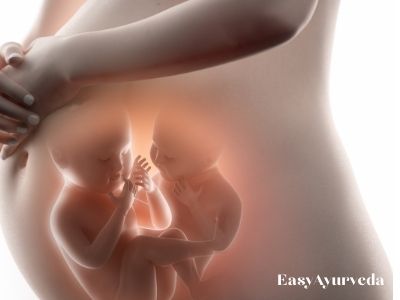
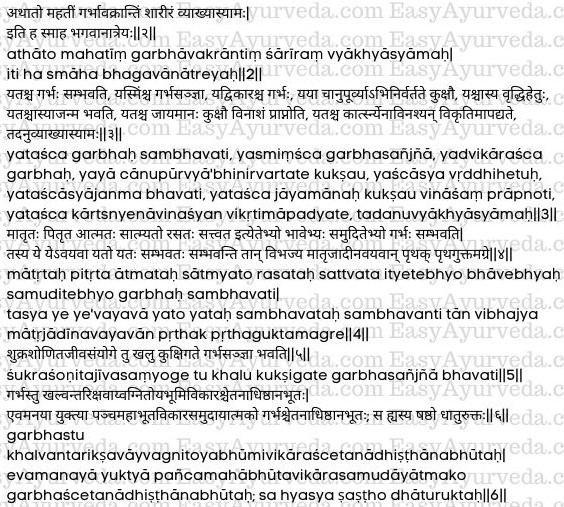
Read – Embryology As Per Ayurveda
Table of Contents
Formation of Embryo
We shall now explore the major chapter on the formation of the Embryo as conducive to the understanding of the body. Thus said Lord Atreya [1-2]
Important Topics discussed in this chapter
We shall now discuss the origin of the embryo, its definition, composition and successive development in the womb, the cause of its growth, the cause of the non-manifestation of the embryo, the cause of destruction of the embryo in the womb and the cause of its morbidity without complete destruction. [3]
Factors composing the foetus
The embryo is formed out of the combination of parents, the Soul, wholesomeness, Rasa (digestive product of mother’s food) and mind. The sources of the respective organs / phenomena like ovum etc. have already been described in greater detail. [4]
Read – Conception And Formation Of Fetus As Per Ayurveda
Definition of term “Garbha”
The union of sperm, ovum and the Soul in the wombs is designed as embryo. [5]
Six elements composing the foetus
The embryo is formed by the five Mahabhutas. Viz, Akasha – ether, Vayu – air / wind, Agni – fire, Jala – water and Prthvi – earth and it serves as the receptacle of consciousness. Applying this principle the foetus represents the combination of five Mahabhutas i.e. five elements of nature and a receptacle of consciousness. The consciousness or soul represents the sixth element of the embryo. [6]
Read – Monthly Development Of Fetus – Ayurvedic perspective
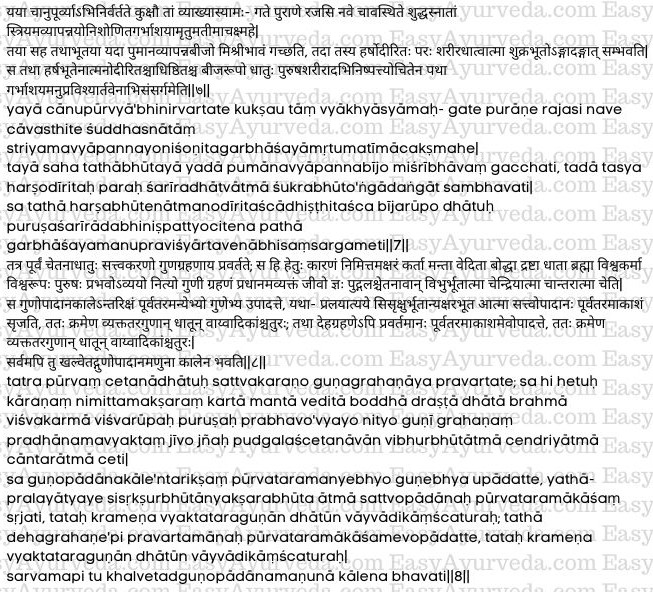
Process of conception
Now we shall explain the order in which the embryo develops in the womb. A woman not suffering from sterility attains the state of fertility after the period of menstruation is over and the formation of fresh blood (inside the uterus) begins, provided she has had purifactory bath and her genital tract, ovum and the uterus are in excellent condition.
If a man with his sperms unimpaired, cohabits with such a woman, his semen which constitutes the essence of the tissue elements of his body, comes out from each and every organ. The semen consisting of sperms impelled by the organs is ejaculated from the body of the man and enters the uterus through the woman’s genital tract and finally unites with the ovum. [7]
Read – Planning for Baby (Conception) with the Help of Ayurveda
Union of Atman
First of all, the conscious element i.e. the Soul endowed with mental equipment i.e. the mind unites with the Mahabhutas i.e. elements of nature. He is known by various names as mentioned below –
- hetu (concomitant cause)
- karana (non-constituent cause)
- nimita (Effective cause)
- akshara (the indestructible one)
- karta (the Agent / the doer)
- manta (the Thinker)
- vedita (the knower)
- boddha (the intelligent one)
- drasta (one who sees, the visionary)
- dhata (the Supporter)
- brahma (the creator)
- vishvakarman (the Builder of the universe)
- visvarupa (the prototype of the universe)
- purusa (the supreme person)
- prabhava (the source of origin)
- avyaya (the indestructible)
- nitya (the eternal)
- guni (the receptacle of mahabhutas)
- grahana (one having capacity to collect / unite the mahabhutas so as to form the body)
- pradhana (the main or predominant one)
- avyakta (the non-manifested one)
- jiva (the one who keeps the living beings in a living condition)
- jna (the conscious one)
- pudgala (the one who goes / jumps from one body to the other)
- cetanavan (one having the consciousness / power to sense)
- vibhu (omnipresent)
- bhutatma (empirical soul)
- indriyatman (organic soul) and
- antraratman (inner soul)
The soul, first of all, unites with Akasha before uniting with the other Bhutas. This is like the creation of Akasha by God / greater soul after the period of deluge. A God, the indestructible one, equipped with the mind creates Akasha first, and then the other Bhutas whose attributes are more and more manifested successively i.e. vayu, agni etc. Similarly the Soul, desirous of creating another body, first of all, unites with the Akasha, and then with other four Bhutas whose attributes are more and more manifested successively i.e. vayu, agni etc. All this action (association of the Soul with the five mahabhutas) takes place in a very short time. [8]
Read – Factors That Harm Fetus, Avoidable Food And Habits In Pregnancy
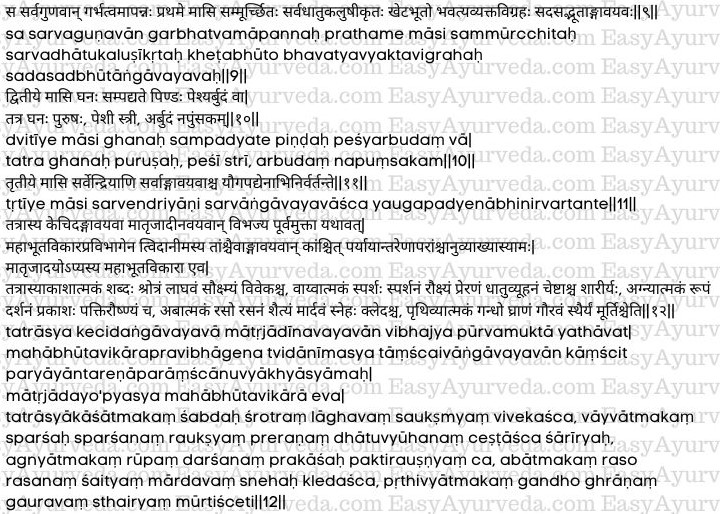
Manifestations during first month
When accompanied with all the attributes, the Soul takes the form of an embryo. During the first month of gestation, it takes the form of jelly because of the intimate mixture of the five Mahabhutas (which get developed in the subsequent months as the tissue elements, i.e. Rasa etc, of the body). During this month, the embryo bears no particular form and the organs of the embryo are both manifested and latent. [9]
Characteristics during second month
During the second month of generation, the embryo takes a compact form in the shape of a knot, elongated muscle or tumour (round and elevated).
- The knot shaped embryo leads to the production of male foetus.
- The muscle shaped embryo leads to the formation of a female foetus.
- The tumour shaped embryo leads to the formation of a eunuch. [10]
Manifestations during third month
During the third month, all the senses and limbs along with their organs manifest themselves simultaneously. [11]
Factors derived from various sources
The description of some of the limbs and organs of the foetus have already been described under various headings such as those derived from mother, those derived from father etc (vide Sharira 3: 6- 18). Different aspects of some of these limbs and organs, and some more will now be described here in a different way of classification, in accordance to their manifestation based on the modifications of various mahabhutas (which form those limbs and organs). In fact, organs derived from mother etc, are nothing but the modifications of the Mahabhutas.
- Sound, the sense organ of sound, lightness, minuteness / subtleness and distinction are derived from Akasha.
- Touch, the sense of touch, roughness, impulsion, formation of different tissues and actions of the body are derived from Vayu.
- Sight, the sense of vision, brightness, digestion and production of heat in the body are derived from Agni.
- Taste, the sense of taste, coldness, softness, unctuousness and dampness (wetness) are derived from Jala.
- Smell, the sense of smell, heaviness, steadiness, and form are derived from Prthvi. [12]
Read – Signs And Symptoms Of Pregnancy – Ayurvedic Perspective
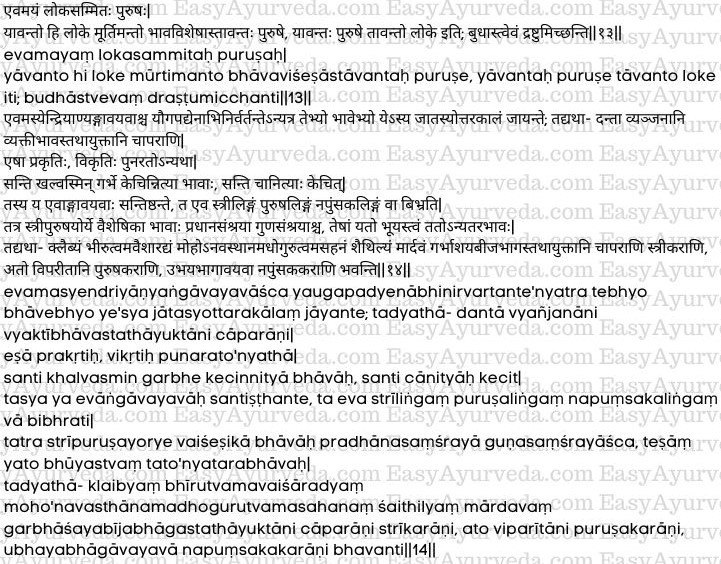
Individual and Universe
Thus the individual is an epitome of the universe. All the material and spiritual phenomena of the universe are present in the individual. Similarly, all those present in the individual are also contained in the universe. This is how the wise desire to perceive [13]
Thus the senses and organs of the foetus are simultaneously manifested except those that are manifested only after birth. For example, teeth, secondary sexual characteristics like bread and breasts, signs of puberty like the production o f semen and ovum and such other traits are developed later. This is the normal and anything other than this is abnormal.
In this foetus, there are some characteristics which are permanent and some others are temporary. These permanent characteristics determine the masculine, feminine or neutral character of the foetus. The characteristics features which determine its male or female sex are either of spiritual or material (Bhautika derived from sperm and ovum) nature. Sex deference is caused by the dominance of one or the other of these factors. For example:
- Weakness
- Timidity
- Lack of wisdom
- Ignorance
- Unsteadiness
- Heaviness of lower limbs
- Intolerance
- Slackness
- Softness
Presence of the uterus and ovary and other characteristic features determine the female sex; opposite traits determine the male sex and in a female sex; opposite traits determine the male sex and in a eunuch both these traits are equally present. [14]
Read – Diet And Lifestyle For Women In Ayurveda
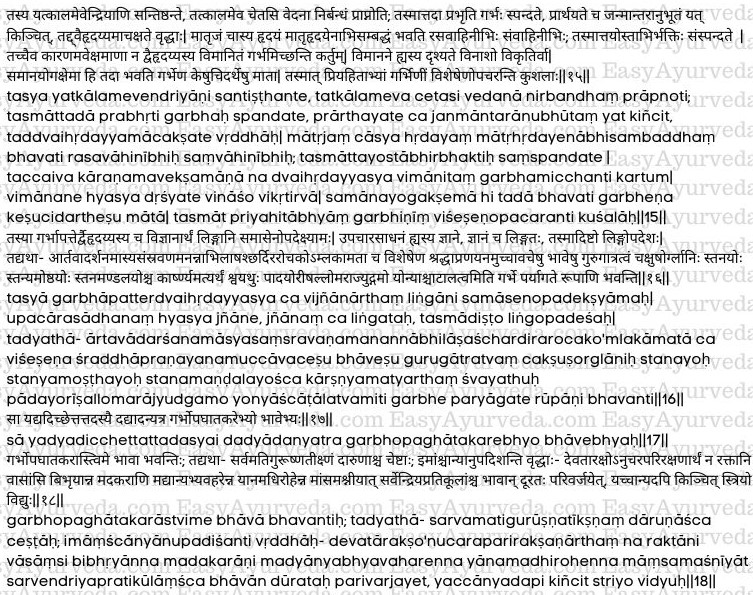
Bi cardiac state
As soon as senses are manifested in the embryo, its mind starts experiencing feelings like pleasure and grief. This is the reason why the foetus starts responding to and getting adjusted to being comfortable with pleasure and also to keep away from grief and pains. It will also start desiring for comfortable feelings that it has experienced since many previous births. The desires of the foetus are exhibited in the form of desires of the mother.
This condition wherein the child’s heart is associated with that of the mother according to the wise is known as Dauharda or bi-cardiac state.
The heart of the foetus which is derived from the maternal source is connected with the mother’s heart through the channels carrying nutrient material.
These channels connecting the foetus and the mother carry the desires of the child to the mother and those of the mother to the child. It is with this perspective that the wise and experienced people advise not to ignore or reject the desires of the mother. This is because if these wishes are ignored or rejected they may cause destruction or deformity in the foetus.
So the wise people insist that the pregnant woman shall be attended with special care so as to fulfil her favourite desires and useful needs.[15]
Read – Pregnancy Cravings – Reasons, Ayurvedic Explanation
Signs of bi cardiac slate
Now we shall explain in brief the signs and symptoms that are indicative of pregnancy as well the bi-cardiac condition. The knowledge of signs and symptoms facilitate the management of these conditions. Therefore, it is necessary to explain their signs and symptoms. They are as follows:
- Stoppage of menstruation
- Excessive salivation
- Loss of appetite
- Vomiting
- Anorexia
- Liking for sour foods
- Liking for all types of foods – both wholesome and unwholesome
- Heaviness of the body
- Feeling of heaviness in the eyes
- Appearance of milk in breasts
- Appearance of excessive darkness in the lips and the areola of breasts
- Slight oedema of feet
- Appearance of small hairs and
- Dilation of vagina [16]
Satisfaction of her desires
The mother should be given whatever she wants during this period except perhaps those that are harmful for the foetus [17]
Factors injurious to foetus
The following are the factors inflicting injury to the foetus:
All things that are very heavy, hot and sharp and
Violent actions like sexual intercourse
Wise men also prescribe the following precautionary measures with a view to avoid any injury to the foetus:
- With a view to be saved of the Gods, Rakshasas (devils) and their followers, she should not use red apparel
- She should not take intoxicant wines
- She should not take meat
- She should not be far away from things as are unwholesome to the senses and
- She should avoid all such things as are advised by (experienced) ladies. [18]
Read – Intrauterine Death Of Fetus In Ayurveda
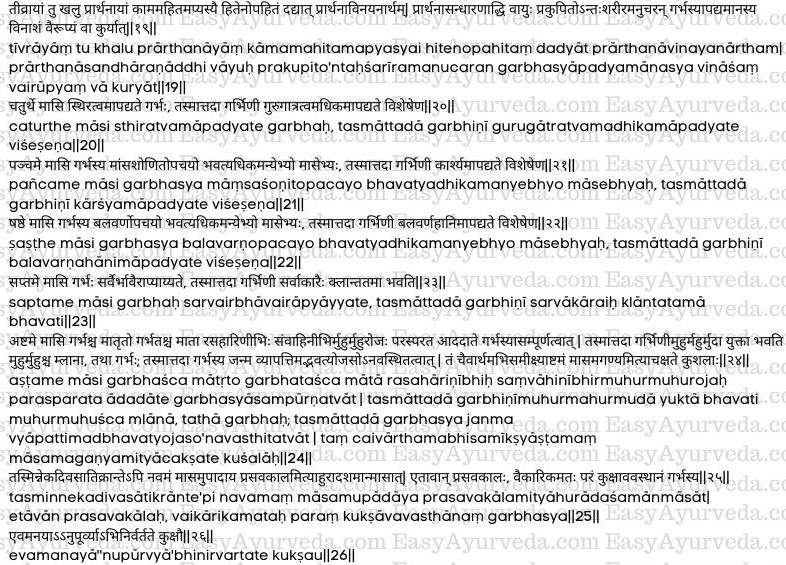
Embryonic defects by ignoring her desires
If the longing is very strong, then even things which are harmful can be given by neutralizing their injurious effects through processing or adding wholesome things. This is necessary with a view to satisfying the desires. By the suppression of the longings, the vata gets vitiated, moves inside the body, and destroys or deforms the foetus in the formative stage. [19]
Developments during fourth month
During the fourth month of gestation, the foetus gets stabilised. Therefore, at that time, pregnant woman specifically experiences excessive heaviness in her body. [20]
Manifestations during fifth month
There is an excessive increase of flesh and blood of the foetus during the fifth month of gestation in comparison to other months. Therefore at that time the pregnant woman grows excessively thinner. [21]
Read – Ayurvedic Diet And Lifestyle For Pregnant Woman
Developments during sixth month
There is excessive increase in the strength and complexion of the foetus during the sixth month of generation in comparison to the other months of gestation. Therefore, at that time the pregnant woman loses her strength and complexion considerably. [22]
Developments during seventh month
There is an all round development of the foetus during the seventh month of gestation. Therefore, a pregnant woman becomes exceedingly deficient in all aspects of her health in the 7th gestational month. [23]
Manifestations during eight month
During the eight month of gestation, the Ojas formed in the body of the foetus moves to the body of the mother and vice versa through the channels carrying nourishment from the mother to the foetus because of the immaturity of foetus.
Therefore at that time the pregnant woman often has a wavering feeling of joy and sorrow. Similar is the condition of the foetus. It is because of this unsteadiness of the Ojas that the delivery of the foetus during this month is considered to be dangerous and risky. In view of this, experts advise that even the reckoning of the eight month of pregnancy should be avoided. This is because if the pregnant woman is constantly aware that she is running through the eighth month of pregnancy she will always be in fear, the fear may also lead to abnormal increase of vata which might consequently cause damage to the foetus. This may further lead to foetal anomalies. [24]
Read – Bleeding During Pregnancy: Causes, Ayurvedic Treatment
Time of delivery
Even the first day after this eight month i.e. from the first day of the ninth month till the end of the tenth month is known as the period of parturition. Normally delivery takes place during this period. Retention of the foetus in the pelvis thereafter is abnormal. [25]
The following factors help in the growth of the foetus in the pelvis of the mother:
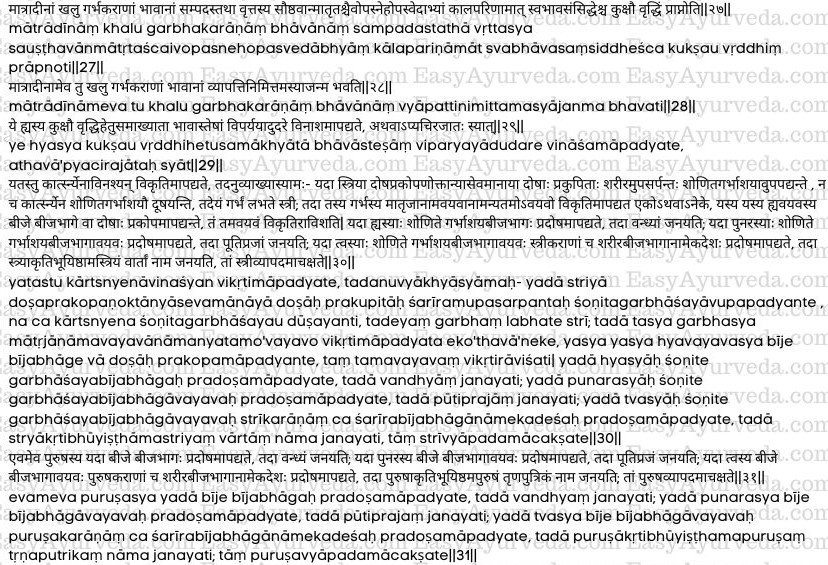
Factors for growth of foetus
The below mentioned factors are responsible for the growth of the foetus –
Excellence of the factors responsible for the production of the foetus which include –
- Maternal factor (ovum
- Paternal factor (sperm)
- Soul
- Wholesomeness
- Digestive product of the mother’s food and
- Mind
Other factors –
- Proper regimen by the mother during pregnancy
- Availability of nourishment and heat through Upasneha (transudation) and (conduction) respectively
- Proper time and
- Instinctive or natural tendencies [27]
Read – Mudha Garbha – Obstructed Labor, Ayurveda Perspective
Factors responsible for absence of birth
Because of the defects in the factors responsible for the production of the foetus i.e. mother (ovum), father (sperm) etc., there is no birth of the child. [28]
Death or delay in delivery of the foetus
The foetus gets destroyed in the pelvis (of the mother) or there is delay in delivery if factors contrary to the ones described for its growth are present. [29]
Causes of deformity in a female child
Factors which lead to deformity and not complete destruction are now being described.
If the woman conceives when her ovum and uterus were not completely vitiated but simply afflicted by the circulating Doshas aggravated because of her indulgence in Dosha aggravating regimens, one or many of the organs of the foetus derived from the maternal source (ovum) i.e. skin, blood etc., get deformed. In the ovum (bija) or whichever part of the ovum (bija bhaga / bijamsha) responsible for the formation of a particular organ the doshas get vitiated, deformity would occur in those ovum / parts of the ovum. Consequently the corresponding organs derived from these Bijas and Bijabhagas get deformed.
When the Bija bhaga (part of the bija) in the ovum of the mother which is responsible for the production of uterus is excessively vitiated, then she gives birth to a sterile child. When the Bijabhagavayava (a fraction of the part of the Bija) in the ovum of the mother which is responsible for the production of the uterus is excessively vitiated, then she gives birth to a foul / fetid smelling child i.e. Puti praja (who delivers dead foetus- c.f commentary).
When the Bijabhagavayava which is responsible for the production of the uterus and also the portions of the Bijabhagas which are responsible for the production of organs that characterize a female, i.e. breasts, genital organ, hair etc. in the ovum of the mother gets excessively vitiated then she gives birth to a child who is not a complete female but only having the feminine characteristics in abundance – such a type of child is known as Varta. These deformities are caused by the vitiation of the ovum and are called as female deformities. [30]
Read – Anomalies, Defects In Fetus, Ayurvedic Treatment
Causes of deformity in a male child
Similarly, when the big / major part of the Bija which is responsible for the production of the sperm in the foetus is excessively vitiated, the child born would be sterile.
When the Bijabhagavayava (only a fraction of the part of the Bija) which is responsible for the production of the sperm is excessive vitiated, then this gives birth to a Putipraja (whose child dies before delivery).
When the Bijabhagavayava which is responsible for the production of sperm and also portions of the Bijabhagas which are responsible for the production of organs that characterise a male, are excessively vitiated, then this gives birth to a child who is not a complete male but only having masculine characteristics in abundance. Such a type of child is known as Trnaputrika.
These deformities are caused by the vitiation of the sperm and are called as male deformities. [31]
Thus the deformities of organs derived from the mother (ovum) and father (sperm) are explained. On the same line the deformities of the organs derived from Stamya (whole someness), Rasa (digestive product of the mother’s food) and Sattva (mind) can be explained. [32]
Read – Foods and Activities that Increase Sattva, Rajas and Tamas
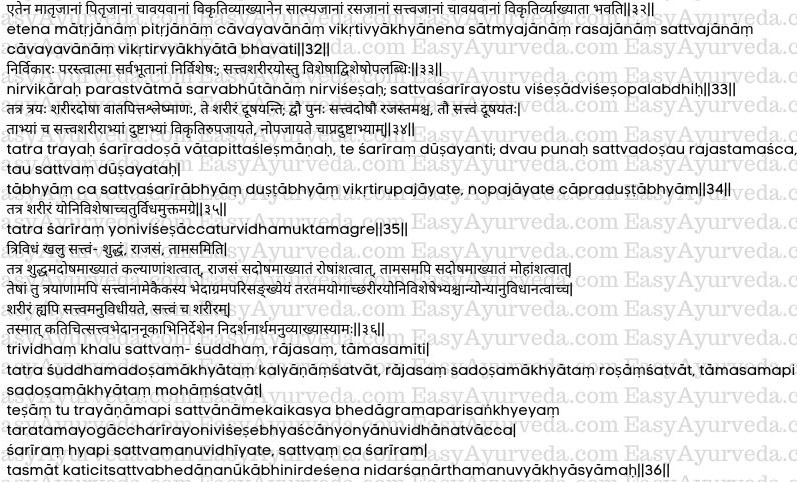
Absolute soul
The absolute soul does not undergo any modification. Its presence in different types of creatures does not bear any distinction. It appears to have distinctions only on account of the specific features of the body and mind of different types of creatures. [33]
Doshas of the body and Mind
Now, there are three physical Doshas (vitiating elements), i.e. Vata, Pitta and Kapha – they vitiate the body. Again there are two mental Doshas i.e. Rajas and Tamas – they vitiate the mind. Vitiation of the body and the mind result in the manifestation of diseases. No diseases are manifested without the vitiation of these doshas. [34]
Read – Manasika Doshas – Satva, Rajas, Tamas As Per Ayurveda
Types of body
Depending upon the Yoni (mode of propagation) the body of animals is already described to be four types – c. F Sharira 3: 16 [35]
Types of mind
Mental faculty is of three types – Satvika, rajasa and Tamasa.
- The Sattvika one is free from defects as it is endowed with auspiciousness.
- The Rajasika type is defective because it promotes wrathful disposition.
- The Tamasika one is similarly defective because it suffers from ignorance.
Each of the three types of mental faculty is in fact of innumerable variety by permutations and combinations of the various factors relating to the body, species and mutual interactions.
Sometimes even the body follows the mind and vice versa. So we shall now explain some of the varieties of mental faculties briefly by way of illustration. [36]
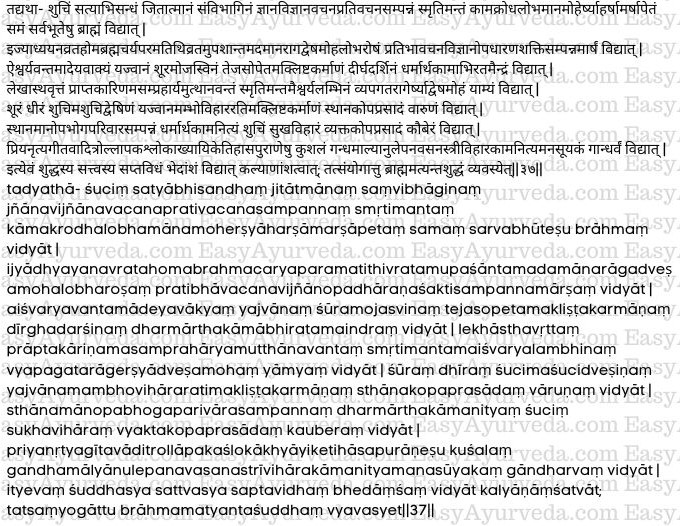
Read – Sub Types Of Personality Features Based On Satva, Rajas, Tamas
Different types of Sattvika individuals
The Sattvika type of mental faculty is auspicious and is of seven categories. Their characteristic features are furnished in the statement given below:
| 1 | Brahma (sharing the traits of Brahma) | 1 | Purity, love for truth, self-controlled |
| 2 | Power of discrimination, material and spiritual knowledge | ||
| 3 | Power of exposition, reply and memory | ||
| 4 | Freedom from passion, anger, greed, ego, ignorance, jealousy, dejection and intolerance and | ||
| 5 | Favourable disposition equally for all creatures. | ||
| 2 | Arsa (sharing the traits of Rshis) | 1. | Devotion to sacred rituals, study, sacred vows, oblations and celibacy |
| 2 | Hospitable disposition | ||
| 3 | Freedom from proved, ego, attachment, hatred, ignorance, greed and anger | ||
| 4 | Intellectual excellence and eloquence and | ||
| 5 | Power of understanding and retention | ||
| 3 | Anidra (sharing the traits of Lord Indra) | 1 | Lord-ship and authoritative speech |
| 2 | Performance of scared rituals | ||
| 3 | Bravery, strength and splendour | ||
| 4 | Freedom from mean acts | ||
| 5 | Far sightedness and | ||
| 6 | Devotion to virtuous acts, earning of wealth and proper satisfaction of desires | ||
| 4 | Yamya (sharing the traits of Yama) | 1 | Observance of the property of actions |
| 2 | Initiation of actions in time | ||
| 3 | Non- violability | ||
| 4 | Readiness for initiating action | ||
| 5 | Memory and lordship | ||
| 6 | Freedom from attachment, envy, hatred and ignorance | ||
| 5 | Varuna (sharing the traits of Varuna) | 1 | Bravery, patience, purity and dislike for impurity. |
| 2 | Observance of religious rites | ||
| 3 | Fondness for mean- acts and | ||
| 4 | Aversion for mean-acts and | ||
| 5 | Exhibition of anger and pleasure in proper place | ||
| 6 | Kauvera (sharing the traits of Kuvera) | 1 | Possession of station, honour, luxuries and attendance |
| 2 | Constant liking for virtuous acts wealth and satisfaction of desires | ||
| 3 | Purity and | ||
| 4 | Liking for pleasures of recreation | ||
| 7 | Gandharva (sharing the traits of Gandharva) | 1 | Fondness for dancing, singing, music and praise |
| 2 | Expertness in poetry, stories, historical narrations and epics | ||
| 3 | Constant fondness for scents, garlands, unguents apparel, association of woman and passion. |
Of the seven types of Sattvika mental faculties described above, the one linked to Brahma is the purest. [37]
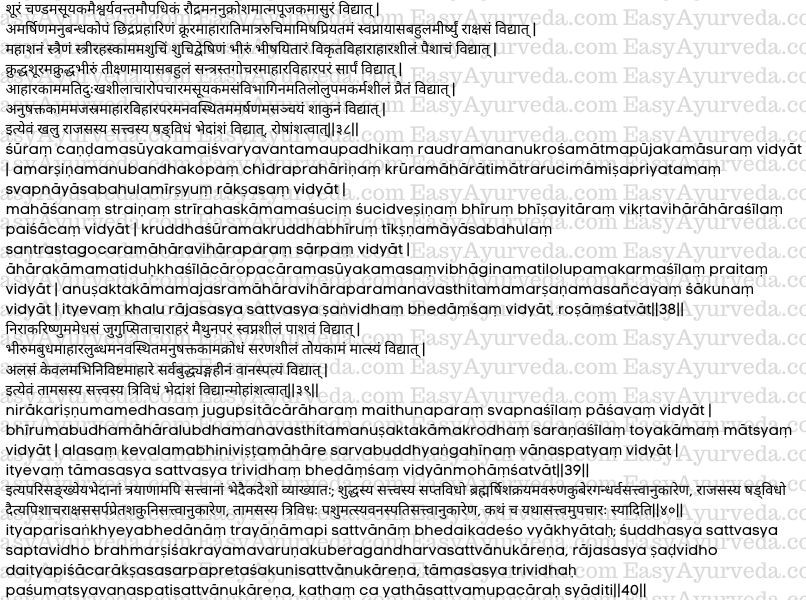
Different types of Rajasa individuals
The Rajasika types of mental faculty represents wrathful disposition and is of six types. Their characteristic features are furnished in the statement given below:
| Types of mental faculty | Characteristic features of the individual | ||
| 1 | Asura | 1 | Bravery, cruelty, envy, lordship movement in disguise, terrifying appearance and ruthlessness and |
| 2 | Indulgence in self praise | ||
| 2 | Raksasa (sharing the traits of Raksasa) | 1 | Intolerance, consent anger, violence at weak points, cruelty gluttonous habits and fondness for non-vegetarian food |
| 2 | Excessive sleep and indolence and | ||
| 3 | Envious sleep and indolence | ||
| 3 | Paisaca (sharing the traits of Pisaca) | 1 | Gluttonous habit |
| 2 | Fondness for women | ||
| 3 | Liking for staying with women in lonely place | ||
| 4 | Unclean habits, disliking for cleanliness | ||
| 5 | Cowardice and terrifying disposition and | ||
| 6 | Resorting to abnormal diet and regimens | ||
| 4 | Sarpa (sharing the traits of Sarpa or Snake) | 1 | Bravery when in wrathful disposition and cowardice when not in wrathful disposition |
| 2 | Sharp reaction | ||
| 3 | Excessive indolence and | ||
| 4 | Walking, talking food and resorting to other regimens with a fearful disposition | ||
| 5 | Praita (sharing the traits of a Preta) | 1 | Excessive desire for food |
| 2 | Excessively painful disposition in character and past times | ||
| 3 | Enviousness and | ||
| 4 | Actions without discrimination excessive greediness and inaction | ||
| 6 | Sakuna(sharing the traits of a Sakuni or Bird) | 1 | Attachment with passion, excessive food and regimen, unsteadiness, ruthlessness and unacquistiveness. [38] |
Read – Personality Types And Features Based On Satva, Rajas, Tamas
Different types of Tamasa Individuals
The Tamasika type of mental faculty represents ignorant disposition and is of three types. Their characteristic features are furnished in the statement given below:
| Type of mental faculty | Characteristic features of the individual | ||
| 1 | Pasava (sharing the traits of animal) | 1 | Forbidding disposition |
| 2 | Lack of intelligence | ||
| 3 | Excessive sexual indulgence and sleep | ||
| 2 | Matsya (sharing the traits of fish) | 1 | Cowardice, lack of intelligence greediness for food, unsteadiness, constant passionate and wrathful disposition and |
| 2 | Fondness for constant movement and desire for water | ||
| 3 | Vanaspatya (sharing the traits of vegetable life) | Indolence, indulgence in food, and defines of all the intellectual faculties. [39] |
Innumerability of the types of mental faculties
The three types of mental faculties have innumerable varieties.
- The sattvika type of mental faculty is of seven types depending upon the dispositions of Brahmi, Rsi, Indra, Yama, Varuna, Kubera and Gandharva.
- The Rajasa type of mental faculty is of six types upon the dispositions of Asura, Raksasa, Pisaca, Sarpa, Preta and Sakuni.
- The Tamasa type of mental faculty is of three types depending upon the dispositions of Pashu (animal), Matsya (fish) and Vanaspati (vegetable life).
All these descriptions are made with a view to indicate the general mode of treatments that should be provided for these types of persons. [40]
The description above is fully in keeping with the purpose with which the chapter was initiated i.e. to provide knowledge one can help resort to the factors which are responsible for the proper growth of the foetus and avoid such factors which come in the way of its proper development. [41]
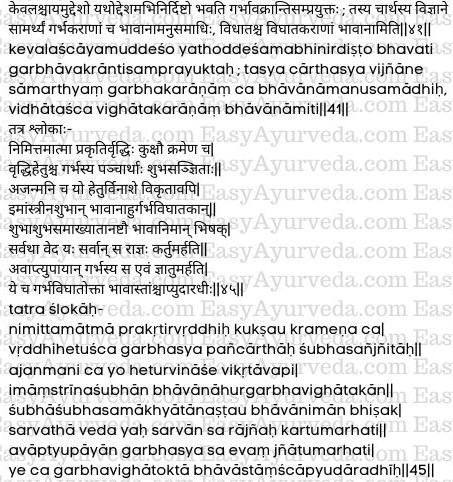
Read – Sattva Pariksha Examination Of The Mind, Tolerance
To sum up
The following topics are discussed in this chapter:
The five auspicious factors, Viz., (a) instrumental cause , (b) Soul, (c) material cause, (d) gradual development of the foetus in the womb and , (e) factors responsible for the growth of the foetus in the womb.
The five inauspicious factors which are injurious to the foetus, viz (a) factors which are responsible for the prevention of conception and (b) destruction of or, (c) deformity in the foetus.
He who knows all aspects of all these eight factors which are auspicious for the foetus is fit to be a royal physician.
An intelligent physician should know those factors which help in the formation and growth of the foetus and also those which are responsible for the destruction of the foetus. [42-45]
Thus ends the fourth major chapter of the Sharira section of “Formation of the Embryo” as conducive to the understanding of the body of Agnivesha’s work as redacted by Charaka. [4]










